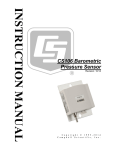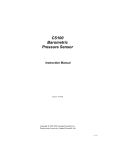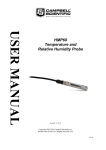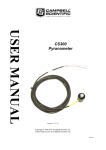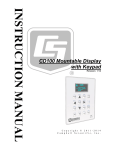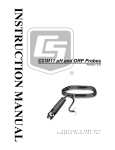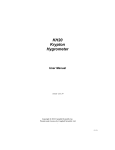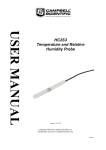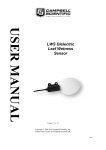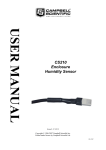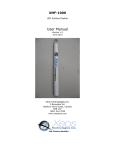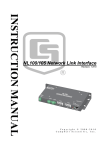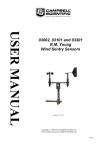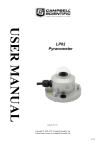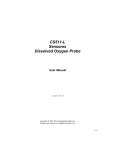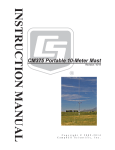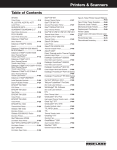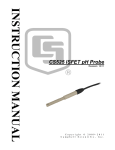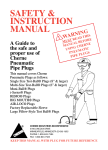Download CS106 Barometric Pressure Sensor
Transcript
USER MANUAL CS106 Barometric Pressure Sensor Issued: 25.2.15 Copyright © 1995-2014 Campbell Scientific, Inc. Printed under licence by Campbell Scientific Ltd. CSL 713 Guarantee This equipment is guaranteed against defects in materials and workmanship. This guarantee applies for 24 months from date of delivery. We will repair or replace products which prove to be defective during the guarantee period provided they are returned to us prepaid. The guarantee will not apply to: Equipment which has been modified or altered in any way without the written permission of Campbell Scientific Batteries Any product which has been subjected to misuse, neglect, acts of God or damage in transit. Campbell Scientific will return guaranteed equipment by surface carrier prepaid. Campbell Scientific will not reimburse the claimant for costs incurred in removing and/or reinstalling equipment. This guarantee and the Company’s obligation thereunder is in lieu of all other guarantees, expressed or implied, including those of suitability and fitness for a particular purpose. Campbell Scientific is not liable for consequential damage. Please inform us before returning equipment and obtain a Repair Reference Number whether the repair is under guarantee or not. Please state the faults as clearly as possible, and if the product is out of the guarantee period it should be accompanied by a purchase order. Quotations for repairs can be given on request. It is the policy of Campbell Scientific to protect the health of its employees and provide a safe working environment, in support of this policy a “Declaration of Hazardous Material and Decontamination” form will be issued for completion. When returning equipment, the Repair Reference Number must be clearly marked on the outside of the package. Complete the “Declaration of Hazardous Material and Decontamination” form and ensure a completed copy is returned with your goods. Please note your Repair may not be processed if you do not include a copy of this form and Campbell Scientific Ltd reserves the right to return goods at the customers’ expense. Note that goods sent air freight are subject to Customs clearance fees which Campbell Scientific will charge to customers. In many cases, these charges are greater than the cost of the repair. Campbell Scientific Ltd, 80 Hathern Road, Shepshed, Loughborough, LE12 9GX, UK Tel: +44 (0) 1509 601141 Fax: +44 (0) 1509 601091 Email: [email protected] www.campbellsci.co.uk PLEASE READ FIRST About this manual Please note that this manual was originally produced by Campbell Scientific Inc. primarily for the North American market. Some spellings, weights and measures may reflect this origin. Some useful conversion factors: Area: 1 in2 (square inch) = 645 mm2 Length: 1 in. (inch) = 25.4 mm 1 ft (foot) = 304.8 mm 1 yard = 0.914 m 1 mile = 1.609 km Mass: 1 oz. (ounce) = 28.35 g 1 lb (pound weight) = 0.454 kg Pressure: 1 psi (lb/in2) = 68.95 mb Volume: 1 UK pint = 568.3 ml 1 UK gallon = 4.546 litres 1 US gallon = 3.785 litres In addition, while most of the information in the manual is correct for all countries, certain information is specific to the North American market and so may not be applicable to European users. Differences include the U.S standard external power supply details where some information (for example the AC transformer input voltage) will not be applicable for British/European use. Please note, however, that when a power supply adapter is ordered it will be suitable for use in your country. Reference to some radio transmitters, digital cell phones and aerials may also not be applicable according to your locality. Some brackets, shields and enclosure options, including wiring, are not sold as standard items in the European market; in some cases alternatives are offered. Details of the alternatives will be covered in separate manuals. Part numbers prefixed with a “#” symbol are special order parts for use with non-EU variants or for special installations. Please quote the full part number with the # when ordering. Recycling information At the end of this product’s life it should not be put in commercial or domestic refuse but sent for recycling. Any batteries contained within the product or used during the products life should be removed from the product and also be sent to an appropriate recycling facility. Campbell Scientific Ltd can advise on the recycling of the equipment and in some cases arrange collection and the correct disposal of it, although charges may apply for some items or territories. For further advice or support, please contact Campbell Scientific Ltd, or your local agent. Campbell Scientific Ltd, Campbell Park, 80 Hathern Road, Shepshed, Loughborough, LE12 9GX, UK Tel: +44 (0) 1509 601141 Fax: +44 (0) 1509 601091 Email: [email protected] www.campbellsci.co.uk Precautions DANGER — MANY HAZARDS ARE ASSOCIATED WITH INSTALLING, USING, MAINTAINING, AND WORKING ON OR AROUND TRIPODS, TOWERS, AND ANY ATTACHMENTS TO TRIPODS AND TOWERS SUCH AS SENSORS, CROSSARMS, ENCLOSURES, ANTENNAS, ETC. FAILURE TO PROPERLY AND COMPLETELY ASSEMBLE, INSTALL, OPERATE, USE, AND MAINTAIN TRIPODS, TOWERS, AND ATTACHMENTS, AND FAILURE TO HEED WARNINGS, INCREASES THE RISK OF DEATH, ACCIDENT, SERIOUS INJURY, PROPERTY DAMAGE, AND PRODUCT FAILURE. TAKE ALL REASONABLE PRECAUTIONS TO AVOID THESE HAZARDS. CHECK WITH YOUR ORGANIZATION'S SAFETY COORDINATOR (OR POLICY) FOR PROCEDURES AND REQUIRED PROTECTIVE EQUIPMENT PRIOR TO PERFORMING ANY WORK. Use tripods, towers, and attachments to tripods and towers only for purposes for which they are designed. Do not exceed design limits. Be familiar and comply with all instructions provided in product manuals. Manuals are available at www.campbellsci.eu or by telephoning +44(0) 1509 828 888 (UK). You are responsible for conformance with governing codes and regulations, including safety regulations, and the integrity and location of structures or land to which towers, tripods, and any attachments are attached. Installation sites should be evaluated and approved by a qualified engineer. If questions or concerns arise regarding installation, use, or maintenance of tripods, towers, attachments, or electrical connections, consult with a licensed and qualified engineer or electrician. General • Prior to performing site or installation work, obtain required approvals and permits. Comply with all governing structure-height regulations, such as those of the FAA in the USA. • Use only qualified personnel for installation, use, and maintenance of tripods and towers, and any attachments to tripods and towers. The use of licensed and qualified contractors is highly recommended. • Read all applicable instructions carefully and understand procedures thoroughly before beginning work. • Wear a hardhat and eye protection, and take other appropriate safety precautions while working on or around tripods and towers. • Do not climb tripods or towers at any time, and prohibit climbing by other persons. Take reasonable precautions to secure tripod and tower sites from trespassers. • Use only manufacturer recommended parts, materials, and tools. Utility and Electrical • You can be killed or sustain serious bodily injury if the tripod, tower, or attachments you are installing, constructing, using, or maintaining, or a tool, stake, or anchor, come in contact with overhead or underground utility lines. • Maintain a distance of at least one-and-one-half times structure height, or 20 feet, or the distance required by applicable law, whichever is greater, between overhead utility lines and the structure (tripod, tower, attachments, or tools). • Prior to performing site or installation work, inform all utility companies and have all underground utilities marked. • Comply with all electrical codes. Electrical equipment and related grounding devices should be installed by a licensed and qualified electrician. Elevated Work and Weather • Exercise extreme caution when performing elevated work. • Use appropriate equipment and safety practices. • During installation and maintenance, keep tower and tripod sites clear of un-trained or non-essential personnel. Take precautions to prevent elevated tools and objects from dropping. • Do not perform any work in inclement weather, including wind, rain, snow, lightning, etc. Maintenance • Periodically (at least yearly) check for wear and damage, including corrosion, stress cracks, frayed cables, loose cable clamps, cable tightness, etc. and take necessary corrective actions. • Periodically (at least yearly) check electrical ground connections. WHILE EVERY ATTEMPT IS MADE TO EMBODY THE HIGHEST DEGREE OF SAFETY IN ALL CAMPBELL SCIENTIFIC PRODUCTS, THE CUSTOMER ASSUMES ALL RISK FROM ANY INJURY RESULTING FROM IMPROPER INSTALLATION, USE, OR MAINTENANCE OF TRIPODS, TOWERS, OR ATTACHMENTS TO TRIPODS AND TOWERS SUCH AS SENSORS, CROSSARMS, ENCLOSURES, ANTENNAS, ETC. Contents PDF viewers: These page numbers refer to the printed version of this document. Use the PDF reader bookmarks tab for links to specific sections. 1. Introduction ................................................................ 1 2. Cautionary Statements .............................................. 1 3. Initial Inspection ........................................................ 1 4. Quickstart ................................................................... 1 5. Overview ..................................................................... 4 6. Specifications ............................................................ 4 6.1 6.2 6.3 Operating Range .................................................................................. 4 Accuracy .............................................................................................. 4 General ................................................................................................. 5 7. Installation .................................................................. 5 7.1 7.2 7.3 Jumper Settings .................................................................................... 5 Mounting in the Enclosure ................................................................... 6 Wiring .................................................................................................. 7 7.3.1 Datalogger Connection ................................................................. 7 7.3.2 5-pin Screw Terminal Plug Connector .......................................... 9 7.4 Programming...................................................................................... 10 7.4.1 CRBasic Instructions .................................................................. 10 7.4.2 Edlog Instructions ....................................................................... 10 8. Operation .................................................................. 11 8.1 8.2 8.3 8.4 8.5 Multiplier and Offset Calculation ...................................................... 11 Conversion Factors ............................................................................ 11 Long Lead Lengths ............................................................................ 12 Output Resolution .............................................................................. 12 Correcting Pressure to Sea Level ....................................................... 12 9. Maintenance and Calibration .................................. 13 Appendices A. Importing Short Cut Code Into CRBasic Editor ... A-1 A.1 Importing Short Cut Code into a Program Editor ........................... A-1 A.1.1 CRBasic Datalogger................................................................. A-1 A.1.2 Edlog ........................................................................................ A-2 i B. Example Programs ................................................ B-1 B.1 CRBasic Programs ........................................................................... B-1 B.1.1 Example CR1000 Program Using Sequential Mode ................. B-1 B.1.2 Example CR1000 Program Using Pipeline Mode .................... B-2 B.2 Edlog Program ................................................................................. B-3 Figures 7-1. 7-2. 7-3. 7-4. 8-1. CS106 jumper set to shutdown mode................................................... 6 ENC100 is a very small enclosure that can house one CS106 ............. 7 CS106 wiring diagram ......................................................................... 8 Connector key attached to 5-pin screw terminal plug connector ......... 9 Point slope graph................................................................................ 11 7-1. 8-1. Signal and Ground Connectors for CS106 ........................................... 9 Conversion Factors for Alternative Pressure Units ............................ 12 Tables ii CS106 Barometric Pressure Sensor 1. Introduction The CS106 measures barometric pressure for the range of 500 to 1100 mb. This range equates to from below sea level (as in a mine) to over 15,000 feet above sea level. Designed for use in environmental applications, the CS106 is compatible with all Campbell Scientific dataloggers. 2. 3. Cautionary Statements READ AND UNDERSTAND the Precautions section at the front of this manual. Warning: Failure to protect the sensor from condensation may result in permanent damage. Warning: Improper wiring may damage the CS106 beyond repair. Care should be taken when opening the shipping package to not damage or cut the cable jacket. If damage to the cable is suspected, consult with a Campbell Scientific application engineer. Although the CS106 is rugged, it should be handled as a precision scientific instrument. Initial Inspection 4. Upon receipt of the CS106, inspect the packaging and contents for damage. File damage claims with the shipping company. Quickstart Short Cut is an easy way to program your datalogger to measure the CS106 and assign datalogger wiring terminals. Use the following procedure to get started. 1. Install Short Cut by clicking on the install file icon. Get the install file from either www.campbellsci.com, the ResourceDVD, or find it in installations of LoggerNet, PC200W, PC400, or RTDAQ software. 2. The Short Cut installation should place a Short Cut icon on the desktop of your computer. To open Short Cut, click on this icon. 1 CS106 Barometric Pressure Sensor 2 3. When Short Cut opens, select New Program. 4. Select Datalogger Model and Scan Interval (default of 5 seconds is OK for most applications). Click Next. User Manual 5. Under the Available Sensors and Devices list, select Sensors | Meteorological | Barometric Pressure folder. Select CS106 Barometric Pressure Sensor. Click to move the selection to the Selected device window. Enter the Sea Level Elevation Correction. The default units for the sea level elevation correction is metres; this can be changed by clicking on the Elevation Correction Units box and selecting Feet. Defaults for the barometric pressure measurement and frequency of the measurement are mmHg and Hourly, consecutively. These can be changed by clicking the Barometric Pressure and Measure sensor boxes and selecting different values. 6. After selecting the sensor, click at the left of the screen on Wiring Diagram to see how the sensor is to be wired to the datalogger. The wiring diagram can be printed out now or after more sensors are added. 7. Select any other sensors you have, then finish the remaining Short Cut steps to complete the program. The remaining steps are outlined in Short Cut Help, which is accessed by clicking on Help | Contents | Programming Steps. 3 CS106 Barometric Pressure Sensor WARNING 5. 8. If LoggerNet, PC400, RTDAQ, or PC200W is running on your PC, and the PC to datalogger connection is active, you can click Finish in Short Cut and you will be prompted to send the program just created to the datalogger. 9. If the sensor is connected to the datalogger, as shown in the wiring diagram in step 6, check the output of the sensor in the datalogger support software data display to make sure it is making reasonable measurements. Improper wiring may damage the CS106 beyond repair. Overview The CS106 uses Vaisala’s Barocap® silicon capacitive pressure sensor, which has been designed for accurate and stable measurement of barometric pressure. This barometer is encased in a plastic shell (ABS/PC blend) fitted with an intake port for pressure equalization. The CS106 outputs a linear 0 to 2.5 Vdc signal that corresponds to 500 to 1100 mb. It can be operated in a shutdown or normal mode (see Section 7.1, Jumper Settings). In the shutdown mode, the datalogger switches 12 Vdc power to the barometer during the measurement. The datalogger then powers down the barometer between measurements to conserve power. If the CS106 and datalogger will be housed in different enclosures, the CABLE5CBL-L should be used instead of the cable that is shipped with the CS106. NOTEThe cable attached to the sensor is optional, in Europe and if required can be ordered as a length of CABLE5CBL-L. 6. Specifications Features: Integral switching circuit limits power consumption to measurement cycle Compatible with Campbell Scientific CRBasic dataloggers: CR200(X) series, CR6, CR800 series, CR1000, CR3000, CR5000, and CR9000(X). Also compatible with Edlog dataloggers: CR500, CR510, CR10(X), CR23X, CR7, and 21X 6.1 6.2 4 Operating Range Pressure: 500 mb to 1100 mb Temperature: –40 to +60 °C Humidity: non-condensing Total Accuracy***: 0.3 mb @ +20 °C 0.6 mb @ 0 to +40 °C 1 mb @ –20 to +45 °C 1.5 mb @ –40 to +60 °C Linearity*: 0.25 mb @ 20 °C Hysteresis*: 0.03 mb @ 20 °C Accuracy User Manual Repeatability*: 0.03 mb @ 20 °C Calibration Uncertainty**: 0.15 mb @ 20 °C Long-Term Stability: 0.1 mb per year * Defined as 2 standard deviation limits of end-point non-linearity, hysteresis error, or repeatability error ** Defined as 2 standard deviation limits of inaccuracy of the working standard at 1000 mb in comparison to international standards (NIST) *** Defined as the root sum of the squares (RSS) of end-point non-linearity, hysteresis error, repeatability error and calibration uncertainty at room temperature 6.3 7. General Dimensions: 9.7 x 6.8 x 2.8 cm (3.8 x 2.7 x 1.1 in) Weight: 90 g (3.2 oz) Housing Material: ABS/PC blend Supply Voltage: 10 to 30 Vdc Supply Voltage Control: When the internal jumper is closed, the CS106 is on continually. When the jumper is open, the CS106 can be turned on/off with 5 Vdc/ 0 Vdc. Supply Voltage Sensitivity: negligible Current Consumption: <4 mA (active); <1 A (quiescent) Output Voltage: 0 to 2.5 Vdc Warm Up Time: 1s Pressure Fitting: barbed fitting for 1/8 in I.D. tubing Overpressure Limit: 2000 mb Installation 7.1 Jumper Settings The CS106 can be operated in one of two modes: shutdown and normal. The mode is selected by a jumper located underneath the plastic cover of the barometer. When the jumper is not installed, the CS106 is in shutdown mode and the datalogger turns the CS106 on and off with a control port or excitation channel; to use the excitation channel, the datalogger must be able to provide an excitation voltage of 5 Vdc. When the jumper is installed, the CS106 is in normal mode and powered continuously. NOTE CS106s shipped from Campbell Scientific are configured for shutdown mode (jumper open). 5 CS106 Barometric Pressure Sensor The location of the jumper is shown in Figure 7-1. Jumper Figure 7-1. CS106 jumper set to shutdown mode 7.2 Mounting in the Enclosure To prevent condensation, install the sensor in an environmentally protected enclosure, complete with desiccant, which should be changed at regular intervals. CAUTION Failure to protect the sensor from condensation may result in permanent damage. The CS106 is typically mounted in a Campbell Scientific enclosure next to the datalogger. Campbell Scientific also offers the ENC100 for situations where it is desirable to house the CS106 in its own enclosure (see Figure 7-2). The ENC100 is a 17 cm (6.7 in) x 13.9 cm (5.5 in) x 9.3 cm (3.7 in) enclosure that includes a compression fitting for cable entry, a vent for equalization with the atmosphere, a backplate for mounting the CS106, and hardware for mounting the ENC100 to a tripod, tower, or pole. 6 User Manual Figure 7-2. ENC100 is a very small enclosure that can house one CS106 Remember that for the sensor to detect the external ambient pressure, the enclosure must vent to the atmosphere (i.e., not be “hermetically sealed”). Enclosures purchased from Campbell Scientific properly vent to the atmosphere. NOTE For user-supplied enclosures, it may be necessary to make a vent hole on the outer wall. In this situation, do not make the hole on one of the vertical side walls, as wind blowing around it can cause transient changes in pressure. The mounting holes for the sensor are one-inch-centred 76 mm (three inches) apart, and will mount directly onto the holes on the backplate of Campbell Scientific enclosures. Mount the sensor with the pneumatic connector pointing vertically downwards to prevent condensation collecting in the pressure cavity, and also to ensure that water cannot enter the sensor. 7.3 Wiring 7.3.1 Datalogger Connection Before connecting the barometer to the datalogger, a yellow warning label must be removed from the pigtails. The warning label reminds the user of the importance of properly connecting the barometer to the datalogger. Wiring is shown in Figure 7-3 and Table 7-1. 7 CS106 Barometric Pressure Sensor SeeTable Table 7-1 3-1 Blue – Pressure (VOUT) See SeeTable Table 7-1 3-1 Yellow – Signal Ground (AGND) See Continuous Continuous12 12VDC Vdc Red – 12 VDC (SUPPLY) SeeTable Table 7-1 3-1 Black – Power Ground (GND) See ControlPort Portor orExcitation Excitation Channel Channel Green – Control (EXT. TRIG) Control Ground or Analogue Ground or Analog Ground Clear – Shield (G or AGND) Figure 7-3. CS106 wiring diagram 8 User Manual Table 7-1. Signal and Ground Connectors for CS106 Wire CS106 Terminal Datalogger Single-Ended Measurement Datalogger Differential Measurement Blue VOUT S.E. Input High Side of Diff. Input Yellow AGND AG (CR10(X), CR500, CR510) (Other Dataloggers) Low Side of Diff. Input Black GND (21X, CR7, CR9000(X)) G (Other Dataloggers) (21X, CR7, CR9000(X)) G (Other Dataloggers) Green EXT TRIG Control port (use to turn power on/off) Control port (use to turn power on/off) Red SUPPLY 12 Vdc 12 Vdc Shield Shield G (CR10(X), CR500, CR510) (Other Dataloggers) G (CR10(X), CR500, CR510) (Other Dataloggers) WARNING Improper wiring may damage the CS106 beyond repair. 7.3.2 5-pin Screw Terminal Plug Connector The datalogger connects to the CS106 via a 5-pin screw terminal plug connector. This connector is removable and may be replaced. The replacement connector may come with a connector key attached to it to ensure that the connector is plugged into the CS106 right side up (see Figure 7-4). When the connector is right side up, it will easily plug into the barometer. Figure 7-4. Connector key attached to 5-pin screw terminal plug connector WARNING A 5-pin screw terminal that is plugged in upside down will damage the sensor — perhaps beyond repair. 9 CS106 Barometric Pressure Sensor 7.4 Programming Short Cut is the best source for up-to-date datalogger programming code. Programming code is needed, when creating a program for a new datalogger installation when adding sensors to an existing datalogger program If your data acquisition requirements are simple, you can probably create and maintain a datalogger program exclusively with Short Cut. If your data acquisition needs are more complex, the files that Short Cut creates are a great source for programming code to start a new program or add to an existing custom program. NOTE Short Cut cannot edit programs after they are imported and edited in CRBasic Editor. A Short Cut tutorial is available in Section 4, Quickstart. If you wish to import Short Cut code into either Edlog or CRBasic Editor to create or add to a customized program, follow the procedure in Appendix A, Importing Short Cut Code into CRBasic Editor. Programming basics for CRBasic and Edlog dataloggers are provided in the following sections; more detailed information about multiplier and offset calculations, conversion factors, long cable lengths, resolution, and correcting pressure to sea level is provided in Section 8, Operation. Complete program examples for select dataloggers can be found in Appendix B, Example Programs. 7.4.1 CRBasic Instructions The VoltSE() measurement instruction programs CRBasic dataloggers (CR200(X), CR800-series, CR1000, CR3000, CR5000, CR9000(X)) to measure the CS106. VoltSE( Dest, Reps, Range, SEChan, MeasOff, SettlingTime, Integration, Multiplier, Offset ) At sea level, a multiplier of 0.24 and an offset of 500 will report the barometric pressure in mbar or hPa. The offset will need to be adjusted if the barometer is not at sea level (see Section 8.5, Correcting Pressure to Sea Level). If different barometric pressure units are desired, see Section 8.2, Conversion Factors. Often, the TimeIntoInterval() CRBasic instruction is used to only power the barometer while making the measurements. Atmospheric pressure changes little with time. In most weather station applications, measuring the barometer pressure once an hour is adequate. See Appendix B, Example Programs, for more information. 7.4.2 Edlog Instructions The Volt (SE) (P1) measurement instruction programs Edlog dataloggers (CR500, CR510, CR10(X), CR23X, CR7, and 21X) to measure the CS106. 10 User Manual Volt (SE) (P1) 1: 1 Reps 2: 25 2500 mV 60 Hz Rejection Range 3: 1 SE Channel 4: 1 Loc [ CS106 ] 5: 0.240 Multiplier 6: 500 Offset At sea level, a multiplier of 0.24 and an offset of 500 will report the barometric pressure in mbar or hPa. The offset will need to be adjusted if the barometer is not at sea level (see Section 8.5, Correcting Pressure to Sea Level). If different barometric pressure units are desired, see Section 8.2, Conversion Factors. Often, the If time is (P92) Edlog instruction is used to only power the barometer while making the measurements. Atmospheric pressure changes little with time. In most weather station applications, measuring the barometer pressure once an hour is adequate. See Appendix B, Example Programs, for more information. 8. Operation 8.1 Multiplier and Offset Calculation The multiplier and offset in the VoltSE() CRBasic or Volt (SE) (P1) Edlog instruction convert millivolts to millibar or hPa. The output from the sensor is 0 to 2.5 V or 0 to 2500 mV, and the sensor’s operating range is from 500 to 1100 mbars (hPa). Equation 1 uses these values to calculate the multiplier: Multiplier: m = 1100−500 2500−0 = 600 2500 = 0.24 (1) The offset is the barometric value at sea level (see Equation 2). Offset: o = 500 (mbar or hPa ) The final result according to Figure 8-1 is: y = 0.24 𝑚𝑏𝑎𝑟 𝑚𝑉 + 500 mbar (2) Figure 8-1. Point slope graph 8.2 Conversion Factors In the example programs, the pressure is reported in millibars (mb). To report pressure in different units, multiply the measured pressure by the appropriate conversion factor. This is done by including an expression in a CRBasic program or using Z=X*F (P37) in an Edlog program. See Table 8-1 below for conversion factors. 11 CS106 Barometric Pressure Sensor Table 8-1. Conversion Factors for Alternative Pressure Units 8.3 To find Multiply by hPa or mb 1.0 kPa 0.1 mm of Hg 0.75006 in of Hg 0.02953 Psi 0.0145 Atm 0.00099 Torr 0.75006 Long Lead Lengths There is a 0.06 mV/foot voltage drop in the CS106 signal leads. This voltage drop, in long lead lengths, will raise the barometric reading by approximately 1.44 mb per 100 feet. For lead lengths greater than 20 feet, use the differential instruction (VoltDiff() in CRBasic or Volt (DIFF) (P2) in Edlog) to measure the CS106. 8.4 Output Resolution When storing the values from the CS106 to a datalogger’s final storage location, or to a data table, care must be taken to choose suitable scaling of the reading, or to store the value with adequate resolution to avoid losing useful resolution of the pressure measurement. The default resolution (low resolution) for Campbell Scientific dataloggers is limited to a maximum of four digits. Even then, the maximum digit value that can be displayed is 7999 for the CRBasic dataloggers and 6999 for Edlog dataloggers. If you use this option with barometric data scaled in millibars (hPa), a reading above 799.9 mb for CRBasic dataloggers (699.9 mb for Edlog dataloggers) will lose one digit of resolution (e.g., at 900 mb, the resolution is limited to 1 mb). To retain 0.01 mb resolution, you either need to subtract a fixed offset from the reading before it is stored to avoid exceeding the 799.9 for CRBasic dataloggers (699.9 for Edlog dataloggers) threshold, or output the barometric reading in high resolution format. This can be done by using the IEEE4 format for CRBasic dataloggers or the Resolution (P78) instruction in the Edlog dataloggers. The default data output format for CR200(X) series datalogger is IEEE4. 8.5 Correcting Pressure to Sea Level The weather service, most airports, radio stations, and television stations adjust the atmospheric pressure to a common reference (sea level). Equation 3 can be used to find the difference in pressure between the sea level and the site. That value (dP) is then added to the offset (500 mb in our example programs) in the measurement instruction. U. S. Standard Atmosphere and dry air were assumed when Equation 3 was derived (Wallace, J. M. and P. V. Hobbes, 1977: Atmospheric Science: An Introductory Survey, Academic Press, pp. 59-61). 5.25328 E dP 1013.251 1 44307.69231 12 (3) User Manual The value dP is in millibars and the site elevation, E, is in metres. Add dP value to the offset in the measurement instruction. Use Equation 4 to convert feet to metres. E(m) E( ft) 3.281ft m (4) The corrections involved can be significant: e.g., at 1000 mb and 20 °C, barometric pressure will decrease by 1.1 mb for every 10 metre increase in altitude. 9. Maintenance and Calibration Since the sensor is semi-sealed, minimum maintenance is required: 1. Visually inspect the cable connection to ensure it is clean and dry. 2. Visually inspect the casing for damage. 3. Ensure that the pneumatic connection and pipe are secure and undamaged. The external case can be cleaned with a damp, lint-free cloth and a mild detergent solution. Vaisala recommends recalibration every two years under normal use. In areas where a lot of contaminants are present, recalibration every year is recommended. Contact Campbell Scientific Ltd for an RMA number before returning the sensor for recalibration. Should you lose the five terminal connector (pn #16004), the replacement part can be purchased from Campbell Scientific Ltd. CAUTION The CS106 is sensitive to static when the backplate is removed. To avoid damage, take adequate anti-static measures when handling. 13 Appendix A. Importing Short Cut Code Into CRBasic Editor This tutorial shows: How to import a Short Cut program into a program editor for additional refinement. How to import a wiring diagram from Short Cut into the comments of a custom program. A.1 Importing Short Cut Code into a Program Editor Short Cut creates files that can be imported into either CRBasic Editor or Edlog program editor. These files normally reside in the C:\campbellsci\SCWin folder and have the following extensions: .DEF (wiring and memory usage information) .CR6 (CR6 datalogger code) .CR2 (CR200(X) datalogger code) .CR1 (CR1000 datalogger code) .CR8 (CR800 datalogger code) .CR3 (CR3000 datalogger code) .CR5 (CR5000 datalogger code) .DLD (contain code for CR10(X), CR23X, CR500, CR510, 21X, or CR7(X) dataloggers) The following procedures show how to import these files for editing. A.1.1 CRBasic Datalogger Use the following procedure to import Short Cut code into CRBasic Editor (CR6, CR200(X), CR1000, CR800, CR3000, CR5000 dataloggers). NOTE 1. Create the Short Cut program following the procedure in Section 4, Quickstart. Finish the program and exit Short Cut. Make note of the file name used when saving the Short Cut program. 2. Open CRBasic Editor. 3. Click File | Open. Assuming the default paths were used when Short Cut was installed, navigate to C:\CampbellSci\SCWin folder. The file of interest has a “.CR6”, “.CR2”, “.CR1”, “.CR8”, “.CR3”, or “.CR5” extension, for CR6, CR1000, CR800, CR3000, or CR5000 dataloggers, respectively. Select the file and click Open. 4. Immediately save the file in a folder different from \Campbellsci\SCWin, or save the file with a different file name. Once the file is edited with CRBasic Editor, Short Cut can no longer be used to edit the datalogger program. Change the name of the program file or move it, or Short Cut may overwrite it next time it is used. 5. The program can now be edited, saved, and sent to the datalogger. A-1 Appendix A. Importing Short Cut Code Into CRBasic Editor 6. Import wiring information to the program by opening the associated .DEF file. Copy and paste the section beginning with heading “-Wiring for CRXXX–” into the CRBasic program, usually at the head of the file. After pasting, edit the information such that a ' character (single quotation mark) begins each line. This character instructs the datalogger compiler to ignore the line when compiling the datalogger code. A.1.2 Edlog Use the following procedure to import Short Cut code into the Edlog program editor (CR10(X), CR500, CR510, CR23X, CR7, or 21X dataloggers). NOTE A-2 1. Create the Short Cut program following the procedure in Section 4, Quickstart. Finish the program and exit Short Cut. Make note of the file name used when saving the Short Cut program. 2. Open Edlog. 3. Click File | Document DLD File. Assuming the default paths were used when Short Cut was installed, navigate to C:\CampbellSci\SCWin folder. The file of interest has a “.DLD” extension. Select the file and click Open. The .dld file, which is a type of ASCII machine code, is imported, documented, and, when saved, given a “.CSI” extension. 4. Immediately save the file in a folder different from \Campbellsci\SCWin, or save the file with a different file name. Once the file is edited with Edlog, Short Cut can no longer be used to edit the program. Change the name of the program file or move it, or Short Cut may overwrite it. 5. The program can now be edited, saved, and sent to the datalogger. 6. Import wiring information to the program by opening the associated .DEF file. Copy and paste the section beginning with heading “-Wiring for CRXXX–” into the Edlog program, usually at the head of the file. After pasting, edit the information such that a ; (semicolon) begins each line, which instructs the datalogger compiler to ignore the line when compiling the datalogger code. Appendix B. Example Programs B.1 CRBasic Programs B.1.1 Example CR1000 Program Using Sequential Mode This CR1000 program uses the sequential mode, which is the simplest mode and can be used for most meteorological applications. Although the example is for the CR1000, other CRBasic dataloggers, such as the CR6, CR200(X), CR800, CR850, CR3000, and CR9000(X) are programmed similarly. In the example, the CR1000 measures the CS106 once an hour. To do this, the CR1000 uses a control port to turn on the CS106 one minute before the top of the hour. On the hour, the datalogger measures the CS106, and then turns the CS106 off. This example assumes that the jumper is in the default position (open). 'CR1000 'Declare Variables and Units Public BattV Public PTemp_C Public BP Public BP_mmHg Units Units Units Units BattV=Volts PTemp_C=Deg C BP = hPa BP_mmHg=mmHg 'Define Data Tables DataTable(Table1,True,-1) DataInterval(0,60,Min,10) Sample(1,BP_mmHg,FP2) EndTable DataTable(Table2,True,-1) DataInterval(0,1440,Min,10) Minimum(1,BattV,FP2,False,False) EndTable 'Main Program BeginProg 'Main Scan Scan(5,Sec,1,0) 'Default Datalogger Battery Voltage measurement 'BattV' Battery(BattV) 'Default Wiring Panel Temperature measurement 'PTemp_C' PanelTemp(PTemp_C,_60Hz) 'CS106 Barometric Pressure Sensor measurement 'BP_mmHg' If TimeIntoInterval(59,60,Min) Then PortSet(1,1) If TimeIntoInterval(0,60,Min) Then VoltSe(BP,1,mV2500,1,1,0,_60Hz,0.240,500) BP_mmHg=BP*0.75006 PortSet(1,0) EndIf 'Call Data Tables and Store Data CallTable(Table1) CallTable(Table2) NextScan EndProg B-1 Appendix B. Example Programs B.1.2 Example CR1000 Program Using Pipeline Mode Although this example is for the CR1000, other CRBasic dataloggers, such as the CR6, CR200(X), CR800, CR850, CR3000, and CR9000(X) are programmed similarly. In the example, the CR1000 measures the CS106 once an hour in a program that runs at 1 Hz. In order to keep the CR1000 running in a pipeline mode, the measurement instruction is placed outside the “If” statement. The measurement is made every scan, and the measured value is first written into a temporary variable called "CS106_temp". Once the CS106 is turned on one minute before the hour, the CS106 starts to make the correct pressure measurements. At the top of the hour, the correct value is copied into the current variable called “pressure”, and the sensor is turned off immediately. The program’s integration parameter for the VoltSE() instruction is _60Hz. However, for Eddy Covariance programs or other datalogger programs that are executed at a higher frequency, the integration parameter should be 250 µs instead of _60Hz or _50Hz. This prevents skipped scans. 'CR1000 Datalogger Public CS106_temp, pressure Units pressure = mbar DataTable (met_data,True,-1) DataInterval (0,60,min,10) Sample (1,pressure,IEEE4) EndTable BeginProg PipeLineMode Scan (1,sec,3,0) 'Measurement is made every scan outside the "If" statement VoltSE (CS106_temp,1,mV2500,1,False,0,_60Hz,0.240,500) 'Turn on CS106 one minute before the hour If (TimeIntoInterval (59,60,min)) Then WriteIO (&b1000,&b1000) 'Copy the correct value to a current variable called "pressure" at the top of the hour 'Turn off CS106 after the measurement If (TimeIntoInterval (0,60,min)) Then pressure = CS106_temp WriteIO (&b1000,&b0) EndIf CallTable met_data NextScan EndProg B-2 Appendix B. Example Programs B.2 Edlog Program Although this example is for the CR10X, other Edlog dataloggers, such as the CR510, CR23X, 21X, and CR7, are programmed similarly. In the example, the CR10X turns on the CS106 one minute before the top of the hour using a control port. On the hour the datalogger measures the CS106, and then it turns the CS106 off. ;{CR10X} *Table 1 Program 01: 1 Execution Interval (seconds) ;Turn on CS106 one minute before the hour ; 1: If time is (P92) 1: 59 Minutes (Seconds --) into a 2: 60 Interval (same units as above) 3: 41 Set Port 1 High ;Measure CS106 at the top of the hour ; 2: If time is (P92) 1: 0 Minutes (Seconds --) into a 2: 60 Interval (same units as above) 3: 30 Then Do 3: Volt (SE) (P1) 1: 1 Reps 2: 25 2500 mV 60 Hz Rejection Range 3: 1 SE Channel 4: 1 Loc [ CS106 ] 5: 0.240 Multiplier 6: 500 Offset ;Turn off CS106 ; 4: Do (P86) 1: 51 5: End (P95) ;Store ; 6: If 1: 2: 3: 7: Set Port 1 Low CS106 data once an hour time is (P92) 0 Minutes (Seconds --) into a 60 Interval (same units as above) 10 Set Output Flag High (Flag 0) Real Time (P77) 1: 0110 Day,Hour/Minute (midnight = 0000) ;Store in high resolution mode to retain 0.01 mb resolution ; 8: Resolution (P78) 1: 1 High Resolution 9: Sample (P70) 1: 1 2: 1 *Table 2 Program 01: 0 Reps Loc [ CS106 ] Execution Interval (seconds) B-3 Appendix B. Example Programs *Table 3 Subroutines End Program -Input Locations1 CS106 1 1 1 B-4 CAMPBELL SCIENTIFIC COMPANIES Campbell Scientific, Inc. (CSI) 815 West 1800 North Logan, Utah 84321 UNITED STATES www.campbellsci.com [email protected] Campbell Scientific Africa Pty. Ltd. (CSAf) PO Box 2450 Somerset West 7129 SOUTH AFRICA www.csafrica.co.za [email protected] Campbell Scientific Australia Pty. Ltd. (CSA) PO Box 8108 Garbutt Post Shop QLD 4814 AUSTRALIA www.campbellsci.com.au [email protected] Campbell Scientific do Brazil Ltda. (CSB) Rua Apinagés, nbr. 2018 - Perdizes CEP: 01258-00 São Paulo SP BRAZIL www.campbellsci.com.br [email protected] Campbell Scientific Canada Corp. (CSC) 14532 – 131 Avenue NW Edmonton, Alberta T5L 4X4 CANADA www.campbellsci.ca [email protected] Campbell Scientific Centro Caribe S.A. (CSCC) 300N Cementerio, Edificio Breller Santo Domingo, Heredia 40305 COSTA RICA www.campbellsci.cc [email protected] Campbell Scientific Ltd. (CSL) 80 Hathern Road, Shepshed, Loughborough LE12 9GX UNITED KINGDOM www.campbellsci.co.uk [email protected] Campbell Scientific Ltd. (France) 3 Avenue de la Division Leclerc 92160 ANTONY FRANCE www.campbellsci.fr [email protected] Campbell Scientific Spain, S. L. Avda. Pompeu Fabra 7-9 Local 1 - 08024 BARCELONA SPAIN www.campbellsci.es [email protected] Campbell Scientific Ltd. (Germany) Fahrenheitstrasse13, D-28359 Bremen GERMANY www.campbellsci.de [email protected] Campbell Scientific (Beijing) Co., Ltd. 8B16, Floor 8 Tower B, Hanwei Plaza 7 Guanghua Road, Chaoyang, Beijing 100004 P.R. CHINA www.campbellsci.com [email protected] Please visit www.campbellsci.com to obtain contact information for your local US or International representative.

































